| Weight | 1 lbs |
|---|---|
| Dimensions | 9 × 5 × 2 in |
| host | mouse |
| isotype | IgG2a |
| clonality | monoclonal |
| concentration | concentrate, predilute |
| applications | IHC |
| reactivity | human |
| available size | 0.1 mL, 0.5 mL, 1 mL concentrated, 7 mL prediluted |
mouse anti-INI-1 monoclonal antibody (25) 6231
Price range: $160.00 through $528.00
Antibody summary
- Mouse monoclonal to INI-1
- Suitable for: Immunohistochemistry (formalin-fixed, paraffin-embedded tissues)
- Reacts with: Human
- Isotype:IgG2a
- Control: Brain or astrocytoma
- Visualization: Nuclear
- 0.1, 0.5, 1.0 mL concentrated, 7 mL prediluted
mouse anti-INI-1 monoclonal antibody 25 6231
| target relevance |
|---|
| Protein names SWI/SNF-related matrix-associated actin-dependent regulator of chromatin subfamily B member 1 (BRG1-associated factor 47) (BAF47) (Integrase interactor 1 protein) (SNF5 homolog) (hSNF5) |
| Gene names SMARCB1,SMARCB1 BAF47 INI1 SNF5L1 |
| Protein family SNF5 family |
| Mass 44141Da |
| Function FUNCTION: Core component of the BAF (hSWI/SNF) complex. This ATP-dependent chromatin-remodeling complex plays important roles in cell proliferation and differentiation, in cellular antiviral activities and inhibition of tumor formation. The BAF complex is able to create a stable, altered form of chromatin that constrains fewer negative supercoils than normal. This change in supercoiling would be due to the conversion of up to one-half of the nucleosomes on polynucleosomal arrays into asymmetric structures, termed altosomes, each composed of 2 histones octamers. Stimulates in vitro the remodeling activity of SMARCA4/BRG1/BAF190A. Involved in activation of CSF1 promoter. Belongs to the neural progenitors-specific chromatin remodeling complex (npBAF complex) and the neuron-specific chromatin remodeling complex (nBAF complex). During neural development a switch from a stem/progenitor to a postmitotic chromatin remodeling mechanism occurs as neurons exit the cell cycle and become committed to their adult state. The transition from proliferating neural stem/progenitor cells to postmitotic neurons requires a switch in subunit composition of the npBAF and nBAF complexes. As neural progenitors exit mitosis and differentiate into neurons, npBAF complexes which contain ACTL6A/BAF53A and PHF10/BAF45A, are exchanged for homologous alternative ACTL6B/BAF53B and DPF1/BAF45B or DPF3/BAF45C subunits in neuron-specific complexes (nBAF). The npBAF complex is essential for the self-renewal/proliferative capacity of the multipotent neural stem cells. The nBAF complex along with CREST plays a role regulating the activity of genes essential for dendrite growth (By similarity). Plays a key role in cell-cycle control and causes cell cycle arrest in G0/G1. {ECO:0000250|UniProtKB:Q9Z0H3, ECO:0000269|PubMed:10078207, ECO:0000269|PubMed:12226744, ECO:0000269|PubMed:14604992, ECO:0000269|PubMed:16267391, ECO:0000269|PubMed:16314535, ECO:0000269|PubMed:9448295}. |
| Subellular location SUBCELLULAR LOCATION: Nucleus. |
| Structure SUBUNIT: Component of the multiprotein chromatin-remodeling complexes SWI/SNF: SWI/SNF-A (BAF), SWI/SNF-B (PBAF) and related complexes. The canonical complex contains a catalytic subunit (either SMARCA4/BRG1/BAF190A or SMARCA2/BRM/BAF190B) and at least SMARCE1, ACTL6A/BAF53, SMARCC1/BAF155, SMARCC2/BAF170, and SMARCB1/SNF5/BAF47. Other subunits specific to each of the complexes may also be present permitting several possible combinations developmentally and tissue specific (Probable). Component of the BAF complex, which includes at least actin (ACTB), ARID1A/BAF250A, ARID1B/BAF250B, SMARCA2/BRM, SMARCA4/BRG1/BAF190A, ACTL6A/BAF53, ACTL6B/BAF53B, SMARCE1/BAF57 SMARCC1/BAF155, SMARCC2/BAF170, SMARCB1/SNF5/INI1, and one or more SMARCD1/BAF60A, SMARCD2/BAF60B, or SMARCD3/BAF60C. In muscle cells, the BAF complex also contains DPF3 (PubMed:18765789, PubMed:8895581). Component of neural progenitors-specific chromatin remodeling complex (npBAF complex) composed of at least, ARID1A/BAF250A or ARID1B/BAF250B, SMARCD1/BAF60A, SMARCD3/BAF60C, SMARCA2/BRM/BAF190B, SMARCA4/BRG1/BAF190A, SMARCB1/BAF47, SMARCC1/BAF155, SMARCE1/BAF57, SMARCC2/BAF170, PHF10/BAF45A, ACTL6A/BAF53A and actin. Component of neuron-specific chromatin remodeling complex (nBAF complex) composed of at least, ARID1A/BAF250A or ARID1B/BAF250B, SMARCD1/BAF60A, SMARCD3/BAF60C, SMARCA2/BRM/BAF190B, SMARCA4/BRG1/BAF190A, SMARCB1/BAF47, SMARCC1/BAF155, SMARCE1/BAF57, SMARCC2/BAF170, DPF1/BAF45B, DPF3/BAF45C, ACTL6B/BAF53B and actin (By similarity). Component of the SWI/SNF-B (PBAF) chromatin remodeling complex, at least composed of SMARCA4/BRG1, SMARCB1/BAF47/SNF5, ACTL6A/BAF53A or ACTL6B/BAF53B, SMARCE1/BAF57, SMARCD1/BAF60A, SMARCD2/BAF60B, perhaps SMARCD3/BAF60C, SMARCC1/BAF155, SMARCC2/BAF170, PBRM1/BAF180, ARID2/BAF200 and actin (PubMed:26601204). Binds to double-stranded DNA. Interacts with CEBPB (when not methylated) (PubMed:20111005). Interacts with PIH1D1 (PubMed:22368283). Interacts with MYK and MAEL (PubMed:10319872). Interacts with PPP1R15A (PubMed:10490642, PubMed:12016208). Interacts with DPF2 (PubMed:20460684). Interacts with YWHAZ (PubMed:16959763). Interacts with ERCC6 (PubMed:24874740). Interacts with FOS, FOSB isoform 1 and 2, FOSL1 and FOSL2 (By similarity). {ECO:0000250|UniProtKB:Q9Z0H3, ECO:0000269|PubMed:10319872, ECO:0000269|PubMed:10490642, ECO:0000269|PubMed:12016208, ECO:0000269|PubMed:16959763, ECO:0000269|PubMed:18765789, ECO:0000269|PubMed:20111005, ECO:0000269|PubMed:20460684, ECO:0000269|PubMed:22368283, ECO:0000269|PubMed:24874740, ECO:0000269|PubMed:8895581, ECO:0000303|PubMed:22952240, ECO:0000303|PubMed:26601204}.; SUBUNIT: (Microbial infection) Binds tightly to the human immunodeficiency virus-type 1 (HIV-1) integrase in vitro and stimulates its DNA-joining activity. Interacts with human papillomavirus 18 E1 protein to stimulate its viral replication (PubMed:10365963). Interacts with Epstein-Barr virus protein EBNA-2 (PubMed:8709224). {ECO:0000269|PubMed:10365963, ECO:0000269|PubMed:8709224}. |
| Domain DOMAIN: The N-terminal DNA-binding region is structurally similar to winged helix domains. {ECO:0000305|PubMed:26073604}. |
| Involvement in disease DISEASE: Rhabdoid tumor predisposition syndrome 1 (RTPS1) [MIM:609322]: A familial cancer syndrome predisposing to renal or extrarenal malignant rhabdoid tumors and to a variety of tumors of the central nervous system, including choroid plexus carcinoma, medulloblastoma, and central primitive neuroectodermal tumors. Rhabdoid tumors are the most aggressive and lethal malignancies occurring in early childhood. {ECO:0000269|PubMed:9671307, ECO:0000269|PubMed:9892189}. Note=The disease is caused by variants affecting the gene represented in this entry.; DISEASE: Schwannomatosis 1 (SWN1) [MIM:162091]: An autosomal dominant tumor predisposition syndrome characterized by the development of multiple benign nerve sheath tumors called schwannomas on cranial, spinal, and peripheral nerves, without involvement of the vestibular nerve. Affected individuals may also have multiple meningiomas. {ECO:0000269|PubMed:17357086, ECO:0000269|PubMed:18072270}. Note=Disease susceptibility is associated with variants affecting the gene represented in this entry.; DISEASE: Coffin-Siris syndrome 3 (CSS3) [MIM:614608]: A form of Coffin-Siris syndrome, a congenital multiple malformation syndrome with broad phenotypic and genetic variability. Cardinal features are intellectual disability, coarse facial features, hypertrichosis, and hypoplastic or absent fifth digit nails or phalanges. Additional features include malformations of the cardiac, gastrointestinal, genitourinary, and/or central nervous systems. Sucking/feeding difficulties, poor growth, ophthalmologic abnormalities, hearing impairment, and spinal anomalies are common findings. Both autosomal dominant and autosomal recessive inheritance patterns have been reported. {ECO:0000269|PubMed:22426308, ECO:0000269|PubMed:22726846, ECO:0000269|PubMed:23906836}. Note=The disease is caused by variants affecting the gene represented in this entry. |
| Target Relevance information above includes information from UniProt accession: Q12824 |
| The UniProt Consortium |
Data
Publications
| pmid | title | authors | citation |
|---|---|---|---|
| We haven't added any publications to our database yet. | |||
Protocols
| relevant to this product |
|---|
| IHC |
Documents
| # | SDS | Certificate | |
|---|---|---|---|
| Please enter your product and batch number here to retrieve product datasheet, SDS, and QC information. | |||
Only logged in customers who have purchased this product may leave a review.



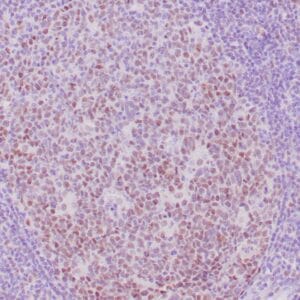


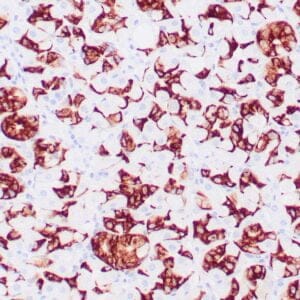

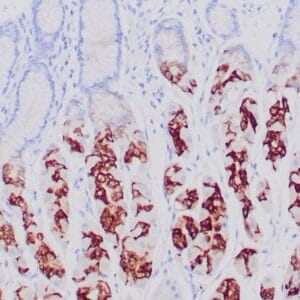



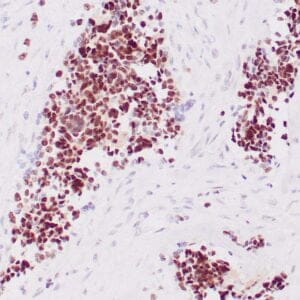


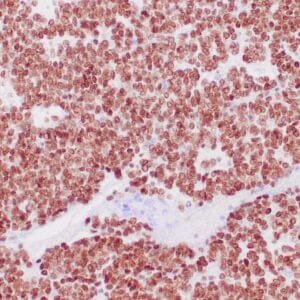
Reviews
There are no reviews yet.